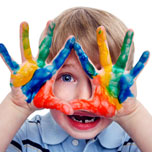 Katie is learning about the food pyramid in her first-grade classroom, when, suddenly, it hits her: She wants to become a farmer! She imagines the smell of the earth as she pulls a fat carrot from the ground. She pictures herself riding high atop a combine, the wind in her hair; selling her vegetables at market; rising with the sun to water her crops. The picture of a sweet country life springs full-blown into her 7-year-old imagination, and she rushes home to tell her mom.
Katie is learning about the food pyramid in her first-grade classroom, when, suddenly, it hits her: She wants to become a farmer! She imagines the smell of the earth as she pulls a fat carrot from the ground. She pictures herself riding high atop a combine, the wind in her hair; selling her vegetables at market; rising with the sun to water her crops. The picture of a sweet country life springs full-blown into her 7-year-old imagination, and she rushes home to tell her mom.
“A farmer?” her mom asks, with surprise and no small amount of derision. “Ick! All that hard work for so little pay? Keep working at your math and you can do better than that! You could be a doctor!”
Every day, in large and small ways, well-meaning parents impose their own opinions, dreams and realities on budding imaginations. Katie’s mom wants the best for her kid — and that includes financial success and stability, something she doesn’t see happening on a farm. But her dismissal represents a tiny death for Katie, a squashing of a thrilling idea, or, as Eric Liu and Scott Noppe-Brandon call it, “the offhand killing of a person’s sense of possibility.”
What’s the big deal? Isn’t being realistic an important job of every parent? Why let crazy dreams like Katie’s run free?
‘A crisis of imagination’
Eric Liu is worried about the unconscious messages we’re all sending kids these days. Liu — a member of the Washington State Board of Education, an author, a former senior advisor to Bill Clinton and a former White House speechwriter — wonders if millions of these small “deaths of possibility,” in homes and in schools, are adding up to something really dangerous for our country and our future.
“I think there is a crisis of imagination right now,” Liu says. “If you look all across our society, you realize that a lot of the challenges we face in our schools — and a lot of our social problems at the neighborhood and national level — boil down to either failures of imagination or neglect of imagination.”
Many educators connect those failures, at least in part, to our schools’ emphasis on testing, which forces teachers to “teach to the test,” stressing rote learning to obtain the highest possible scores in measurable skills. Imagination? Not always so measurable. That’s one reason Liu is now dedicating himself to the study of how imagination is imparted — and inhibited — in our schools.
“Our education system doesn’t do nearly enough to emphasize, reward, honor and teach imagination and creativity,” Liu says, largely because of the emphasis on testing. “We’re losing some of the spirit of imagination.”
Liu wrote the book on imagination — literally — with co-author Scott Noppe-Brandon, the executive director of the Lincoln Center Institute. Out this month, Imagination First takes a hard look at what the authors see as a systemic devaluing of imagination — and what it’s costing us.
“If we merely cram kids full of a lot of what, we leave them utterly unready for what if,” they write. And it’s that “what if” that is at the underpinning of personal — and institutional — success.
What’s killing imagination?
So what’s causing this crisis of imagination? Ironically, it could be success itself, according to Liu. “The crisis of imagination is the direct result of abundance,” he says. “When you have more video games and media products, and places to go and trips to go on, a lot of possibility is just presented to you,” leaving no room for imagination.
Linda Hartzell, the creative director of Seattle Children’s Theatre, agrees. “Kids are watching television and playing video games so much; the stories, games and ideas are all provided for them. They’re not asked to use their imagination.
“You see it in drama class: When asked to imagine stories on their own, the children — especially the younger children — very, very quickly will develop ideas using their imaginations. The older they get, though, the longer it takes them, because of the habit of having the stories provided for them.”
The antidote for this? Limits, says Liu. Cut back on the media, cut back on the frantic scheduling of kids, and you’re using a powerful tool to recharge kids’ imaginations.
But the wholesale squashing of imagination isn’t just happening at home, according to veteran teacher Judy Morgenweck, who’s taught in public and private schools from Alaska to Enumclaw, Bellevue to Whidbey Island. She says part of the problem lies in the way teachers teach.
“I can remember a man coming in to teach teachers how to teach kids to write,” years ago in Enumclaw, Morgenweck says. “He said, ‘You must always, always, always have the kids write first and draw later, because if you let them draw first, that’s all they’ll do.’” Morgenweck had a student in her second-grade class at the time who was a gifted cartoonist. “To him, a story was the artwork — with words attached,” she says. “I would totally squash that kid if I said, ‘I’m sorry, you can’t draw first, you must write.’”
“In public schools, it’s arts and crafts — it’s not imagination,” Morgenweck says, describing a fellow teacher who had students create paper toy soldiers every year at Christmas. “The teacher cut out all the pieces, and the kids followed all the directions,” she says. “All the soldiers faced to the right. The one I loved was a little boy’s — it faced left!”
Changing the way teachers teach is critical, agrees Lynn Eisenhower, arts facilitator for the Tacoma Public School District. “If the grownups could figure out how to approach their work more creatively, the kids would be fine,” she says. “I think it’s astoundingly important that education leadership be creative and imaginative.
“Public education is a slow beast to move, and to shift the system is going to require very creative, imaginative leaders, and there’s risk to be taken in going there,” she says, even as she goes there. A brand-new program in Tacoma middle schools is stretching the boundaries of imaginative teaching. The project — through Arts Impact, a federally funded program that trains teachers — is introducing visual arts (and next year, movement) in the unlikeliest of places: math class.
Students at three Tacoma middle schools — First Creek, Angelo Giaudrone and Jason Lee — will learn about math in a whole new way this year: through art. For seventh-graders, for example, that means using scale, proportion and color knowledge to build kites. “The math has to be right or the kite doesn’t fly!” says Eisenhower. The district hopes to grow the program to all 10 middle schools in the future.
“The teachers are so enthused,” Eisenhower says. “They know we really have to see imagination as valued, or we’ll get further and further behind by getting boxed in.”
 Why imagination matters
Why imagination matters
Getting behind is a big worry for Liu and others, who plan to do something about it. “When you think about what makes a state like ours great, and what our lasting competitive advantage in the world is, it’s that we’ve always been a great source of imagination,” says Liu. “In business, technology, philanthropy, spirituality — there’s always new stuff coming out of the Northwest, and that doesn’t happen by accident. We need to make sure our kids are steeped in a culture of imagination.”
Imagination leads to creativity, which leads to innovation, Liu and Noppe-Brandon write, and nobody denies the primacy of innovation, especially around here, birthplace of the personal computer and countless soaring advances in aerospace technology.
In fact, creativity is crucial to the future economic success of our country, according to a 2007 report by the National Center on Education and the Economy tellingly titled “Tough Choices or Tough Times.”
”The best employers the world over will be looking for the most competent, most creative and most innovative people on the face of the earth and will be willing to pay them top dollar for their services,” states the report, which also says that the United States’ future status as a world economic leader will depend on a “deep vein of creativity that is constantly renewing itself.”
Macroeconomics aside, imagination matters for the success of every one of our kids, says Eisenhower. “I think for K–12 students, imagination is the key to their successful lives,” she says. “The kinds of workers that the world needs are problem solvers, who can look at problems from a different perspective and see many possibilities.”
Liu, Noppe-Brandon and a host of other “imagination” thinkers and movers are going large and public with this discussion, organizing a special event, “An Imagination Conversation,” at Seattle’s McCaw Hall later this month (ParentMap is a sponsor; see below for details). Parents, educators and business leaders are invited to attend to discuss — and imagine — where and how we go from here.
What you can do
While educators and business leaders work to fix the system, parents can play a crucial — if quieter — role in their homes. “Everyone can raise their level of imagination and readiness to apply it,” according to Liu, who wants to help you do just that. Imagination First lists 28 1/2 exercises (or “practices”) to inspire imagination in everyday life. Try a few with your kids, or try the game Liu likes to play with his 10-year-old daughter, Olivia: Draw a keyhole shape. Then draw something inside that shape and have your child imagine what is behind the door.
Be open to silliness — and be silly yourself. “Model and speak the idea that there’s nothing more delightful, honorable and praiseworthy than being willing to be wrong, wacky and cut against the grain,” Liu says. “Parents are under so much pressure in the arms race of educational experience, and that breeds a real conformity. It’s high-end conformity, but it’s still conformity, and that saps the spirit of imagination.”
Make imagination a part of the routine — and don’t be worried about mess. “Have creative materials handy,” suggests Morgenweck. “Have a place where they can slop and mess around.” Morgenweck’s classrooms always include an “invention box”: a cardboard box full of cast-off and recycled objects, such as coffee-creamer lids, pipe cleaners, strawberry containers and painter’s tape — simple (and cheap!) items that can be used for inventing at home, too.
“Live it more,” says Shelley Thomas, an art teacher who owns Early Masters Art School in Seattle. “Go to the library together and get excited about a topic. Say, ‘We’re going to find everything we can about the Greeks,’ and then just have a week where everything is Greek, and you make Greek food and you make an olive-leaf crown.
“Celebrate their creativity and their imagination by making it come alive.”
And don’t lose sight of your own role in all of this, says Hartzell. “The biggest mistake you can make as a parent is to not be brave yourself. Be imaginative, and be willing to play and use your own imagination and engage with the child.”
After all, when kids’ imaginations are turned on, the results can be surprising. “A few weeks ago, I was teaching a class on [abstract expressionist] Mark Rothko,” says Thomas. “I was showing one painting and trying to explain, and a child raised her hand and said, ‘It looks like a door to heaven to me.’ And I thought ‘Class is over.’ The fanciest art critic couldn’t have said it better.”
“Every one of us is a creative, imaginative person,” says Eisenhower. “It’s in each of us. How it’s cultivated, what we do with it — and whether we can hold onto it as we grow up and as we learn — that’s the key.”
Kristen Russell Dobson once imagined being paid to write for a living. Her 12-year-old daughter wants to be a veterinarian, a chef or a teacher, and her 9-year-old son wants to be a video-game designer.
Boost your imagination!
Here are a few great ideas for boosting your kids’ imaginations — and yours!
 1. Finish the story. Tell the child a story, but have her make up the ending.
1. Finish the story. Tell the child a story, but have her make up the ending.
2. Swap bodies. Role-play with your child. “To not be you is a great liberator of the imagination,” according to Imagination First.
3. Play with limits. Give a child five random items (pencil, rubber band, empty box, toilet-paper roll, penny) and ask them to invent a device (a burglar alarm, a time-travel machine, an ice cream maker). Save odd cast-offs in an “invention box” (egg cartons, strawberry baskets, mint tins, etc.), along with masking tape and pipe cleaners.
4. What is it? Hartzell suggests showing the child an object - such as a pencil, ruler, small box - and ask him to dream up an entirely different use for it, and create a scene around it. One catch: It cannot be used as what it really is.
Sources: Eric Liu and Scott Noppe-Brandon, Linda Hartzell and Judy Morgenweck
Resources
Books:
Imagination First by Eric Liu and Scott Noppe-Brandon
Mindset: The New Psychology of Success by Carol S. Dweck
Scamper: Creative Games and Activities for Imagination Development by Bob Eberle
Henry’s Amazing Imagination by Nancy Carlson
Unplugged Play: No Batteries. No Plugs. Pure Fun by Bobbi Conner
Websites:
Seattle Children’s Theatre









